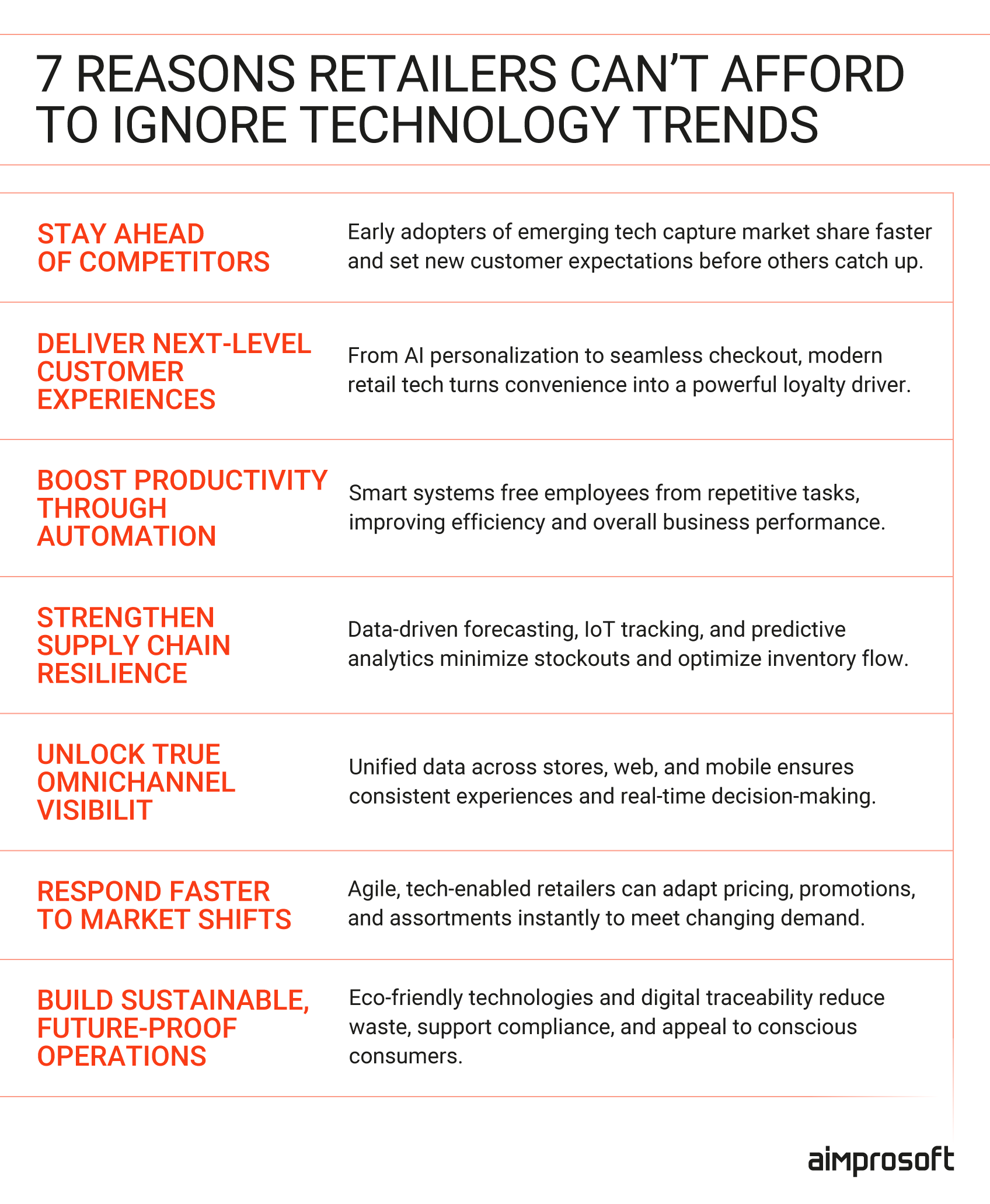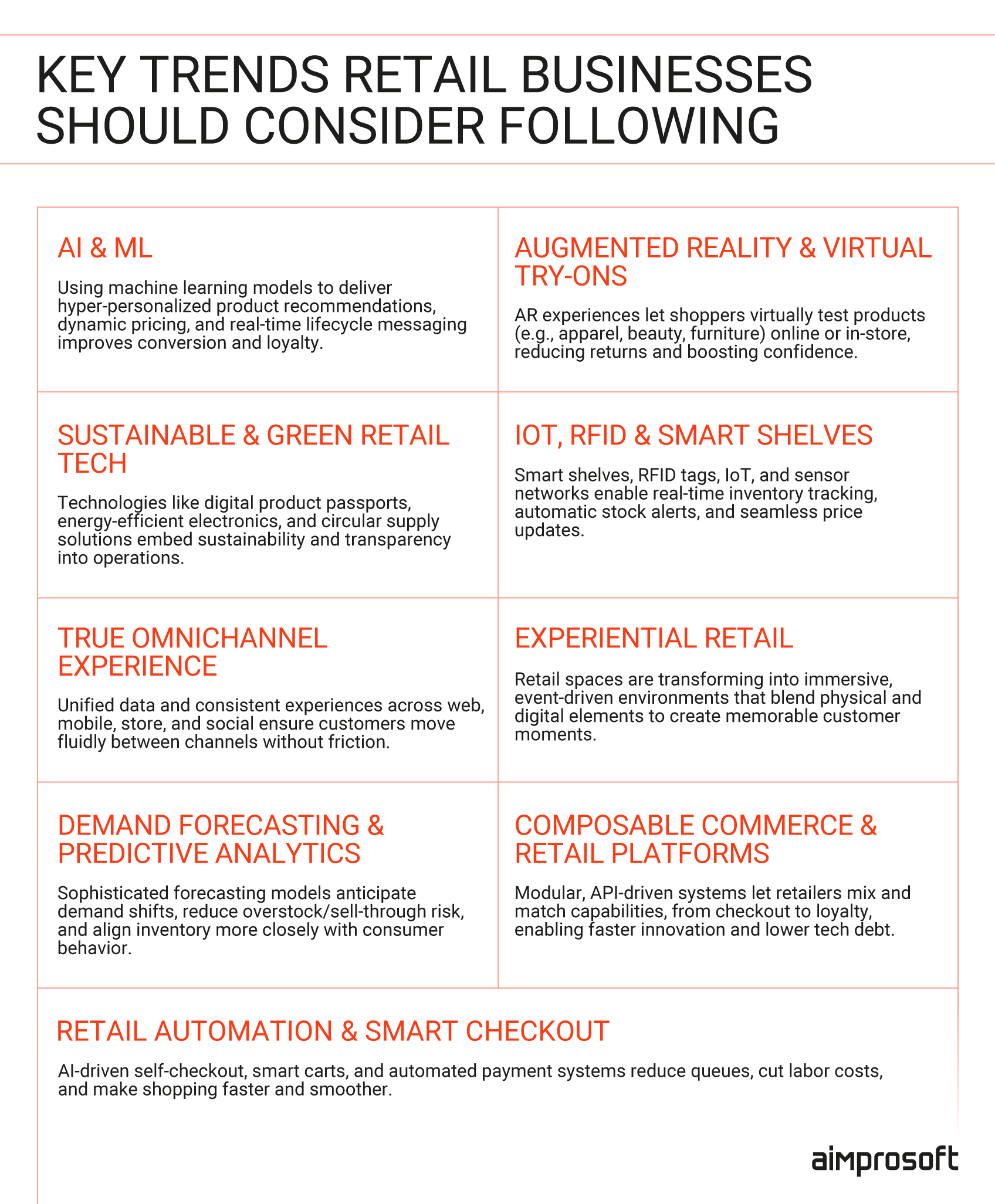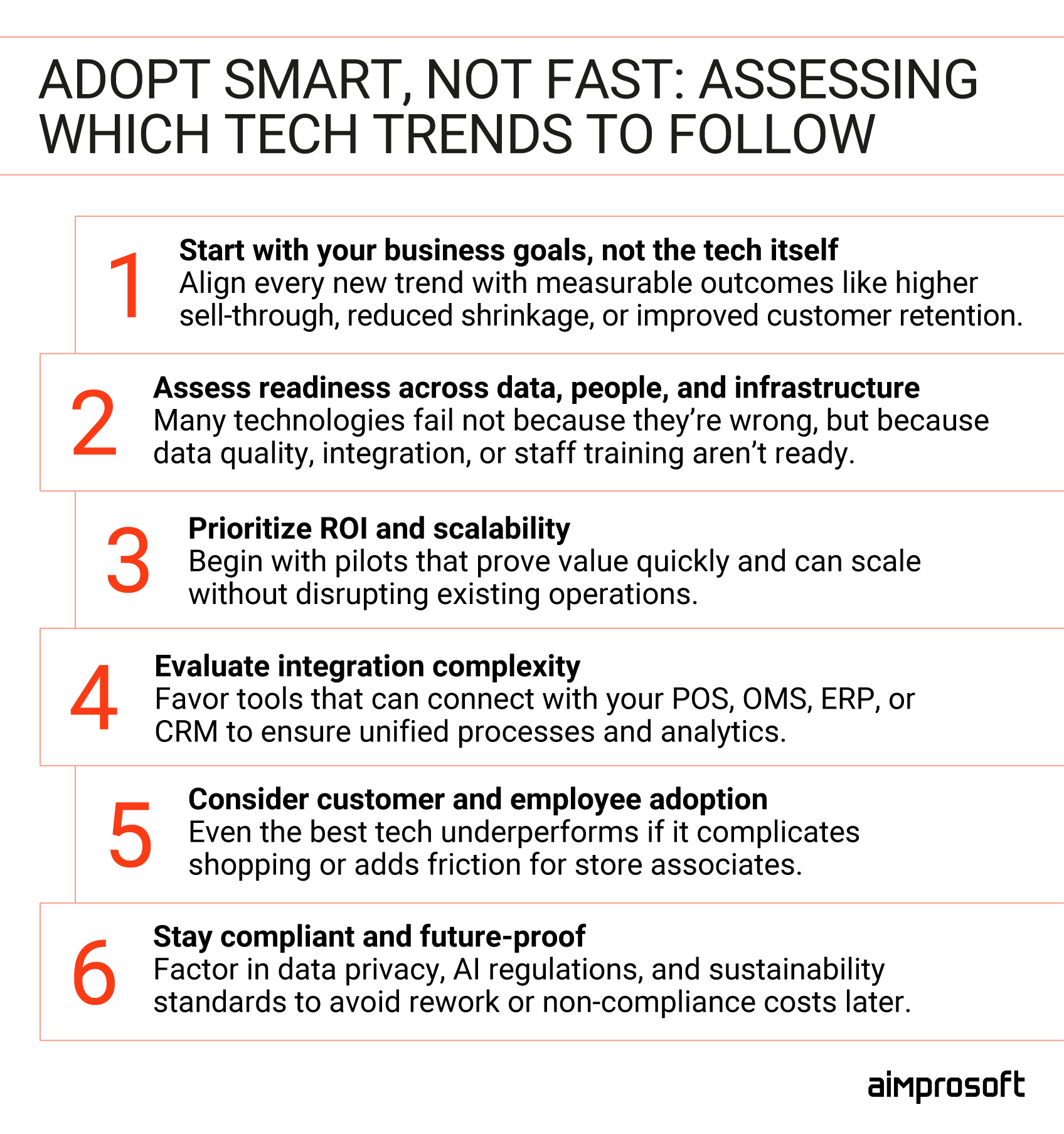Top 9 Retail Technology Trends Shaping the Future of Shopping
Everywhere you look, there’s a new “must-have” retail technology. AI promises to personalize every interaction. Automation claims to solve staffing shortages. IoT connects shelves, carts, and sensors into smart ecosystems. And if you believe the headlines, every one of these tools is the secret to staying relevant, the silver bullet that will boost competitiveness and increase ROI.
But must every retailer really follow all the latest retail trends? The truth is, not every innovation fits every business. A small chain doesn’t need robotics built for mega-warehouses, and not every brand will benefit from virtual try-ons or blockchain-backed supply chains. The real challenge isn’t adopting what’s trending, but understanding what’s truly worth your time, effort, and budget.
Our goal with this article is to cut through the noise. We’ll explore the most influential retail technology trends shaping the industry today. More importantly, we’ll show how to tell the difference between hype and opportunity, and how to choose the innovations that can genuinely strengthen your business.
Why following retail technology trends delivers real value
The retail sector is entering a new reality shaped by rising costs, cautious consumers, and shrinking margins. According to KPMG’s Global Consumer & Retail CEO Outlook, 81% of executives expect the cost-of-living crisis to affect their organizations for at least the next three years. To stay profitable, you can no longer rely on traditional models. You must understand how customers behave, where demand shifts, and how technology can help you adapt faster than your competitors.
Consumer expectations are now the main force behind this transformation. Shoppers are not passive buyers anymore. They expect personalization, speed, and flexibility across every channel. Research from Comcast Business shows that 42% of retailers list improving customer experience as their top goal for digital transformation. Technologies like AI, IoT, and advanced analytics are helping them move from reacting to anticipating needs, turning data into more meaningful interactions and long-term loyalty.
This shift is already reshaping the industry’s scale and structure. According to research published by Grand View Research, the AI in retail market was valued at 11.6 billion USD in 2024 and is projected to reach 40.7 billion USD by 2030, growing more than 23% annually. Meanwhile, 73% of shoppers use multiple channels before making a purchase, and retailers with seamless omnichannel strategies see revenue growth nearly three times higher than those that don’t. Retail digital transformation has moved from experiment to expectation, becoming the foundation of both customer trust and business resilience.

Core reasons you should keep up with retail trends
Stay ahead of competitors
Technology rarely waits for slow movers. The retailers that experiment first set the tone for everyone else. Early adopters of AI-driven recommendations, dynamic pricing, or smart checkout don’t just react to retail tech trends; they shape what customers come to expect next. Deloitte’s 2024 Retail Industry Outlook found that data-driven retailers are 23% more likely to outperform their competitors in decision-making speed and customer responsiveness. Staying ahead now means leading by example, not by image. The brands that innovate set the pace for everyone else.
Deliver next-level customer experiences
Experience is the new currency of loyalty. Shoppers remember how easy it was to find what they wanted, not just what they paid for. Technologies such as AI personalization and virtual try-ons create moments that feel effortless and relevant. A McKinsey study found that advanced personalization can deliver a 10–15% increase in revenue and make marketing spend far more efficient. Great experiences are built on data, but they are felt emotionally by every customer who walks away satisfied.
Boost productivity through automation
Retailers are under constant pressure to deliver more with fewer resources. Automation helps you focus on what truly drives performance. From smart inventory systems to self-checkout and automated fulfillment, routine work becomes faster, more accurate, and less dependent on manual labor. The retail automation market, which includes POS, inventory automation, and robotics, was valued at 24.12 billion USD in 2023 and is projected to reach 44.84 billion USD by 2030, according to Grand View Research. That growth reflects how automation is moving from experiment to everyday practice, improving both efficiency and the employee experience.
Strengthen supply chain resilience
Reliable delivery has become one of the strongest measures of success in retail. Unexpected shortages or delayed shipments erode trust and profit. Predictive analytics and IoT-based tracking help teams anticipate demand swings and spot risks before they hit the shelf. McKinsey reports that applying AI-driven forecasting to supply chains can reduce errors by 20 to 50% and translate into up to 65% fewer lost-sales and product-unavailability events. In an unpredictable world, resilience becomes the most efficient path to performance.
Unlock true omnichannel visibility
Customers no longer think in terms of channels; they think in moments. They browse on their phones, check availability in-store, and expect both to reflect the same reality. Integrating data across web, mobile, and physical stores creates that unified picture. Research shows that omnichannel shoppers deliver a 30% higher lifetime value than those who buy through a single channel. Visibility turns complexity into opportunity, allowing every part of your business to move in sync.
Respond faster to market shifts
Technology trends in retail industry can change overnight. What worked yesterday might no longer fit how people browse or buy. Real-time analytics, dynamic pricing tools, and automated inventory systems help retailers spot those shifts early and adjust before they become costly. When demand starts leaning toward new product categories, AI-driven forecasting can redirect stock to the right locations or channels within days. The ability to experiment, measure, and respond quickly turns uncertainty into opportunity.
Build sustainable, future-proof operations
Sustainability has become part of how shoppers define value. Modern consumers expect transparency, traceability, and visible impact from the brands they buy. A 2024 survey by Simon-Kucher found that 54% of consumers are willing to pay a premium for sustainable products and services. Retailers that invest in greener technologies, digital traceability, and responsible sourcing not only meet regulations but earn deeper loyalty and long-term resilience.
Following retail business technology trends isn’t about chasing every new idea. It’s about understanding where innovation aligns with your goals, resources, and brand promise. In the next section, we’ll explore the specific technologies shaping the future of shopping and how to evaluate which ones genuinely fit your business.
Top retail technology trends shaping the future of shopping
Retail has become one of the most dynamic testing grounds for innovation. From AI-assisted personalization to smart shelves that track stock in real time, technology now defines how retailers connect with customers, manage operations, and plan for the future. The following retail digital transformation trends stand out not because they’re new, but because they’re gaining measurable traction across the industry. Each of them reflects a shift in how retailers think about growth, moving less towards chasing novelty and more towards creating intelligent, adaptive systems that can evolve with the market.

Top 9 retail trends that are currently shaping retail market
1. AI & ML: turning data into personalized retail experiences
Adoption of AI retail trends can help retailers translate raw data into decisions that improve customer experience and operational performance. Instead of relying on assumptions, algorithms analyze shopper behavior, inventory flow, and pricing patterns in real time. This allows businesses to offer personalized product recommendations, optimize pricing dynamically, predict demand more accurately, and prevent fraud before it happens.
The benefits extend across the organization. Personalization drives higher conversion rates, demand forecasting reduces waste and out-of-stock situations, and automation in customer interactions cuts operational costs while improving response time. As AI models become more efficient and easier to integrate, they empower even medium-sized retailers to act with the speed and precision of large enterprises.
Key AI retail technology trends and applications are:
- Personalized product recommendations and dynamic content
- Dynamic pricing and promotion optimization
- Inventory management and replenishment planning
- Visual recognition for shelf analysis and checkout
- Fraud detection and risk scoring
- Customer sentiment analysis and behavioral segmentation
| When AI & ML trend is worth adopting | When it might not bring immediate value |
|---|---|
| When your product catalog and customer base are large enough to generate meaningful data | When your data is fragmented, outdated, or too limited for model training |
| When you aim to improve marketing ROI or personalize offers across digital and physical channels | When your team lacks analytical expertise or resources to interpret insights |
| When operational inefficiency or stock discrepancies directly affect profit | When personalization would not significantly impact customer choice (e.g., niche luxury brands with curated selections) |
| When competition relies heavily on convenience and speed of service | When the cost of integration exceeds short-term benefits |
Real-world examples
- Sephora uses AI as a “Beauty Advisor” to personalize site content and product suggestions, tailoring each visitor’s experience based on behavior and preferences.
- Stitch Fix relies on machine learning algorithms to match clothing selections with individual customer preferences, improving retention and reducing return rates.
- H&M integrates AI into assortment planning and product design, using trend and sales data to decide which items to produce and where to stock them, helping reduce unsold inventory and increase sell-through rates.
Considering AI adoption but want a clear, low-risk path forward? Our article on AI consulting explains how expert guidance transforms uncertainty into results.
2. Augmented reality & Virtual try-ons: bringing products closer to customers before purchase
Augmented reality (AR) and virtual try-on technologies allow shoppers to preview products digitally before committing to a purchase. They reduce uncertainty, improve confidence, and bridge the sensory gap that often exists in online shopping. Customers can visualize how furniture fits their space, how a shade of lipstick looks on their skin, or how sneakers match an outfit, all from their phone or in-store screen.
For retailers, AR is more than a novelty. It improves conversion rates, lowers return rates, and helps collect valuable behavioral data on what customers virtually test. According to Snap and Deloitte’s AR Consumer Report, 75% of global consumers expect to use AR as part of their shopping journey by 2025. This shift shows how immersive visualization is becoming a mainstream expectation rather than an experimental feature.
Key applications of AR & virtual try-on in retail
- Virtual fitting rooms for apparel and accessories
- Beauty and cosmetics try-on experiences
- Furniture and home decor visualization
- In-store navigation and interactive product displays
- AR packaging and product storytelling
- Live AR events and digital storefronts
| When adopting AR brings measurable value | When AR may not be the right priority |
|---|---|
| When your products rely on visual appeal, color, or fit (fashion, beauty, furniture, jewelry) | When your audience primarily shops in-store and relies on physical experience |
| When online returns are high due to customer hesitation or sizing uncertainty | When your product catalog has low visual differentiation (e.g., consumables, generic items) |
| When your goal is to create immersive brand experiences that drive engagement | When development costs for 3D assets outweigh potential ROI |
| When you already have high-quality 3D product visuals or can easily produce them | When your website or app infrastructure isn’t ready for heavy AR integrations |
Real-world examples
- IKEA launched the IKEA Place app, enabling customers to visualize how furniture fits and looks in their homes, which significantly reduced return rates and increased buyer confidence.
- L’Oréal uses AR through its ModiFace technology, letting users virtually test makeup shades and hair colors; this feature increased online conversion rates and time spent on product pages.
- Warby Parker introduced virtual try-on for eyeglasses through its mobile app, allowing customers to see frames on their faces in real time, improving both purchase confidence and satisfaction.
3. Sustainable & Green retail tech: reducing waste and building long-term trust
Sustainability has moved beyond branding. For modern retailers, it’s a business necessity shaped by consumer expectations and regulation alike. Green technology solutions for retail help companies reduce waste, optimize energy use, and build transparency across the entire supply chain. From digital product passports and energy-efficient equipment to recyclable packaging and AI-powered demand forecasting, sustainability now drives both cost savings and customer loyalty.
The financial case is equally strong. According to PwC’s 2024 “Voice of the Consumer” survey, consumers are willing to spend on average 9.7 % more for sustainably produced or sourced goods. This shift shows that environmental responsibility is no longer an optional marketing angle. It directly influences purchasing decisions and long-term retention.
Key applications of sustainable retail innovation technology
- Energy-efficient lighting, HVAC, and refrigeration systems
- Digital receipts and paperless checkout
- AI-driven demand forecasting to reduce overproduction and waste
- Circular commerce and product take-back programs
- Supply chain traceability and digital product passports
- Eco-friendly packaging and logistics optimization
| When sustainability-focused tech adds real value | When it might not deliver immediate ROI |
|---|---|
| When sustainability aligns with your brand values and customer expectations | When sustainability initiatives are isolated rather than integrated into operations |
| When you aim to reduce operational costs tied to energy, materials, or logistics | When customer expectations in your category prioritize price or convenience over ethics |
| When regulations require more transparent reporting and traceability | When the cost of technology upgrades exceeds measurable savings in the short term |
| When you want to differentiate through responsible business practices | When your supply chain partners aren’t ready to support traceability or circular programs |
Real-world examples
- H&M Group introduced digital product passports to track material origins and manufacturing impact, improving transparency and aligning with EU sustainability goals.
- Nike implemented a global recycling initiative and digital inventory management systems that cut material waste and reduced logistics emissions.
- Unilever adopted advanced analytics to monitor carbon output across its supply chain, helping the company identify high-impact areas and meet its net-zero commitments faster.
4. IoT, RFID & Smart shelves: making retail operations visible, connected, and efficient
Internet of Things (IoT) technologies are transforming how retailers monitor and manage their operations. RFID tags, smart shelves, and electronic shelf labels (ESLs) create a connected environment where every product, device, and display communicates in real time. Together, they help track inventory, prevent stockouts, enable dynamic pricing, and provide insights into how customers interact with products on the floor.
These systems bring measurable gains in efficiency and accuracy. According to Avery Dennison’s RFID adoption study, retailers using item-level RFID achieved inventory accuracy rates above 98%, up from an industry average of 65–75%. That visibility not only reduces losses but also supports omnichannel fulfillment by ensuring the right products are always available in the right locations.
Key applications of IoT, RFID & smart shelf technology
- Real-time inventory tracking and replenishment
- Smart shelves that detect stock movement or tampering
- Electronic shelf labels for instant price updates
- Cold-chain monitoring in grocery and pharmacy retail
- Asset tracking across warehouses and stores
- Automated checkout and shrinkage prevention
| When these technologies deliver strong results | When adoption may not be practical |
|---|---|
| When high inventory accuracy directly impacts sales (fashion, grocery, electronics) | When the product range or sales volume doesn’t justify the upfront investment |
| When you manage multiple store locations or fulfillment centers | When store layout or materials interfere with sensor accuracy |
| When you want to synchronize online and in-store stock levels for click-and-collect or same-day delivery | When legacy POS or ERP systems can’t yet integrate with IoT or RFID platforms |
| When your business faces high costs from overstocking, shrinkage, or manual audits | When operational staff aren’t trained to act on the data collected |
Real-world examples
- Decathlon implemented item-level RFID tagging across global stores, achieving near-perfect inventory accuracy and significantly reducing checkout times.
- Walmart expanded its RFID program from apparel to home goods and electronics, improving inventory visibility and supporting omnichannel fulfillment.
- Kroger introduced smart shelves equipped with digital price labels and sensors that track stock levels, reducing manual restocking and pricing errors.
5. True omnichannel experience: creating one continuous customer journey
The line between physical and digital shopping has all but disappeared. Customers now expect one consistent experience, whether they’re browsing online, trying items in-store, or completing purchases through mobile or social channels. A true omnichannel strategy connects every touchpoint, marketing, inventory, logistics, and customer service into a single, seamless ecosystem.
This isn’t just about convenience; it’s a measurable driver of growth. Research from Porch Group Media found that omnichannel shoppers have a 30% higher lifetime value than those who purchase through a single channel. By synchronizing data and eliminating silos, retailers can engage customers in real time, optimize stock levels, and create the kind of frictionless experience that encourages repeat visits and long-term loyalty.
Key elements of a true omnichannel strategy
- Unified commerce platforms integrating online and in-store data
- Consistent pricing, promotions, and loyalty programs across channels
- Real-time inventory visibility for click-and-collect and ship-from-store
- Centralized customer data and communication history
- Cross-channel customer support and returns management
- Personalization across marketing, email, and digital storefronts
| When omnichannel investment drives the most value | When it may not be the right immediate focus |
|---|---|
| When your customers move frequently between digital and physical touchpoints | When your brand operates in a purely digital or local niche with minimal cross-channel interaction |
| When product availability and delivery speed strongly affect conversion | When you lack accurate inventory data or logistical capacity to support flexible fulfillment |
| When your existing systems can already share or synchronize data | When integrating systems would be more disruptive than beneficial in the short term |
| When integrating systems, it would be more disruptive than beneficial in the short term | When your marketing data is still fragmented across tools or departments |
Real-world examples
- Target connected its app, website, and stores through a unified fulfillment system, allowing customers to check local inventory, order online, and pick up within hours, boosting same-day sales by over 200% year over year.
- Nike created a single digital identity across web, app, and store interactions, enabling personalized offers and faster checkout for loyalty members.
- Best Buy integrated online recommendations with in-store consultations and delivery scheduling, creating a consistent experience that increased cross-channel conversions.
6. Experiential retail: turning shopping into memorable engagement
Experiential retail focuses on creating immersive, emotionally engaging environments where customers interact with products and brands beyond a simple transaction. It blends storytelling, technology, and service design to make shopping feel like an experience rather than an errand. Whether through interactive displays, pop-up events, or AR-powered spaces, innovation in retail stores turns everyday visits into memorable moments that strengthen brand connection and inspire loyalty.
This approach delivers tangible business benefits. A PwC Consumer Insights survey found that 73% of shoppers consider experience an important factor in their purchasing decisions. Retailers that focus on engagement often see higher dwell times, improved conversion rates, and greater word-of-mouth marketing as customers share those experiences online.
Key applications of experiential retail
- Immersive pop-up stores and brand activations
- Interactive in-store technology (touchscreens, AR/VR experiences)
- Product customization and on-demand creation zones
- Community-driven events and workshops
- Sensor-based or gamified environments that reward engagement
- Flagship store designs centered on brand storytelling
| When experiential retail delivers real value | When it may not be the right focus |
|---|---|
| When your brand thrives on emotional connection or lifestyle positioning | When customers prioritize price and convenience over experience |
| When in-store traffic needs to be re-energized after digital growth | When store locations or layouts limit possibilities for immersive setups |
| When your target audience values novelty, exclusivity, or personalization | When marketing budgets or staff availability restrict event execution |
| When you have the marketing and operational resources to sustain regular activations | When ROI from engagement activities is difficult to quantify within short cycles |
Real-world examples
- Starbucks Reserve Roasteries transformed coffee retail into a multi-sensory experience with on-site roasting, tasting flights, and immersive storytelling, attracting visitors as much for the atmosphere as the product.
- Lululemon built experiential stores offering yoga studios, cafes, and community events, strengthening its position as a lifestyle brand and boosting repeat visits.
- Adidas launched interactive concept stores where customers can personalize sneakers on-site and test them in digital environments, increasing engagement and in-store conversions.
7. Demand forecasting & Predictive analytics: anticipating demand before it happens
In retail, timing is everything. Demand forecasting and predictive analytics allow businesses to anticipate customer needs, manage inventory with precision, and make smarter pricing and merchandising decisions. By analyzing historical sales, social signals, and market data, predictive models reveal what products customers will want, when, and in what quantity.
The payoff is tangible. According to McKinsey research, data-driven decisions around stock and store optimization have increased sales by 10%. Not only does accurate forecasting reduce waste, it also builds agility, allowing retailers to adapt faster, align supply with demand, and capture opportunities before competitors do.
Key applications of demand forecasting & predictive analytics
- Sales and inventory forecasting
- Seasonal trend and event-based demand prediction
- Price and promotion optimization
- Supplier and replenishment planning
- Predictive logistics and fulfillment
- Category management and product lifecycle tracking
| When predictive analytics brings a strong ROI | When it may not yield immediate returns |
|---|---|
| When your inventory or assortment is large and changes frequently | When data sources are inconsistent or insufficient to train forecasting models |
| When supply chain or logistics efficiency directly affects margins | When operations depend on unpredictable variables like bespoke manufacturing |
| When your business depends on accurate seasonal or regional forecasting | When short-term promotions or impulse buying dominate sales |
| When you aim to reduce markdowns, overstock, or waste | When there’s limited alignment between planning, sales, and procurement teams |
Real-world examples
- Amazon uses predictive analytics for demand forecasting and automated restocking, allowing it to anticipate product demand across regions and minimize delivery delays.
- Zara (Inditex Group) leverages real-time sales data and predictive modeling to adjust production weekly, reducing excess inventory and keeping collections aligned with customer demand.
- Walmart employs advanced analytics for supplier coordination and stock optimization, lowering out-of-stock rates and ensuring consistent product availability across stores.
Learn how a predictive analytics platform can transform decision-making. Read our Avora case study and see how we turned data into measurable growth.
8. Retail automation & Smart checkout: streamlining operations for speed and efficiency
Retail automation combines software, sensors, and AI-driven systems to remove friction from everyday operations. Smart checkout technology, from self-service kiosks to computer vision and mobile payments, helps customers complete purchases faster while reducing staffing pressures and operational costs. Automation also extends beyond checkout, powering real-time pricing updates, replenishment, and predictive maintenance.
The scale of adoption is accelerating. According to Fortune Business Insights, retailers plan to automate up to 70% of daily in-store tasks by 2025, cutting costs and improving efficiency across operations. The same report projects that half of all inventory and pricing checks will be handled by robots or automation systems within the next year. This shift marks a turning point where automation is no longer a differentiator but an operational standard for modern retail.
Key applications of retail automation & smart checkout
- Self-checkout kiosks and cashierless payment systems
- AI-powered vision checkout (scanless or frictionless stores)
- Automated inventory replenishment and ordering
- Electronic shelf labels for price updates
- Chatbots and virtual store assistants
- Queue and crowd management through sensors and analytics
| When automation delivers strong results | When it may not be the right option |
|---|---|
| When your stores face high transaction volume or frequent staffing shortages | When store layouts or transaction volumes make automation underused |
| When reducing checkout times is directly tied to sales or satisfaction metrics | When your audience values human interaction as part of the brand experience |
| When you operate multiple locations and need consistent operational standards | When infrastructure or bandwidth can’t support smart devices and sensors |
| When efficiency gains can offset the upfront technology investment | When cost savings are uncertain compared to manual operations |
Real-world examples
- Sam’s Club introduced AI-powered exit verification that replaces manual receipt checks, cutting average queue time from minutes to seconds.
- Amazon Go pioneered computer-vision checkout that lets customers walk out without scanning, reducing staffing needs and improving customer flow.
- Carrefour implemented hybrid self-checkout zones combining mobile scanning and traditional terminals, boosting throughput and improving satisfaction scores.
9. Composable commerce & Retail platforms: building flexible foundations for growth
Modern retailers are moving away from rigid, monolithic systems toward modular, API-driven platforms that let them choose and integrate the tools they need. This composable approach allows businesses to mix and match best-of-breed retail industry technology solutions, such as CMS, payment gateways, inventory systems, and personalization engines, without disrupting existing infrastructure. The result is faster innovation, easier scaling, and lower long-term technical debt.
Adoption is growing quickly. According to research, 72% of retailers have already adopted composable approaches in some form. This shift reflects a broader industry realization: flexibility, not feature count, determines how fast retailers can respond to change.
Key applications of composable commerce & retail platforms
- Modular eCommerce architectures built with microservices and APIs
- Integration of headless systems such as CMS, PIM, CRM, and OMS for unified content and data management
- API orchestration layers that connect third-party tools like payment gateways, analytics, and marketing automation
- Dynamic storefront composition that allows brands to create tailored experiences for different markets or audiences
- Centralized management of digital assets across channels and brands
| When composable commerce delivers value | When it may not be the best option |
|---|---|
| When your current eCommerce platform limits speed or customization | When your digital maturity is still low, and existing systems meet current needs |
| When your business spans multiple brands, regions, or digital touchpoints | When development resources or technical talent are limited |
| When you need to integrate new tools quickly without replatforming | When a full re-architecture could disrupt ongoing operations |
| When innovation cycles or product launches require agility | When third-party integrations may introduce unnecessary complexity |
Real-world examples
- LEGO rebuilt its digital ecosystem using composable commerce principles, allowing faster deployment of new experiences and reducing time-to-market for product launches.
- Burberry adopted a headless architecture to unify its online and in-store experiences, improving consistency and speeding up innovation cycles.
- Mars, Inc. implemented composable retail platforms across multiple brands, gaining centralized data control and faster integration of AI-driven personalization.
Partner with experts who turn emerging tech into real customer and business value.
Technology in retail isn’t about chasing every new innovation. It’s about identifying which tools align with your goals, resources, and customers. The retail and technology trends shaping the industry today (AI, automation, IoT, sustainability, and others) are not standalone solutions but interconnected parts of a smarter, more adaptive ecosystem.
Retailers who approach innovation strategically, testing what truly fits rather than following hype, will build the kind of flexibility that lasts. The future of retail technology belongs to those who stay curious, data-aware, and ready to evolve when the next opportunity appears.
Adopt smart, not fast: assessing which retail technology trends to follow
Retail innovation never stands still. New retail technology solutions emerge faster than most businesses can evaluate them, and what seems revolutionary one year can become outdated the next. The retailers who succeed aren’t those who chase every new idea but those who adopt technologies deliberately, aligning each decision with business goals, capabilities, and measurable value. Below are six principles that help ensure every technology investment pays off.

Principles that will help you adopt the right retail trend
1. Start with your business goals, not the tech itself
Technology should follow strategy, not the other way around. Before exploring new platforms or pilot projects, define what aspect of your business you want to improve, such as higher sell-through, lower shrinkage, smoother customer journeys, or better retention. Clear goals turn technology from an experiment into a growth driver. The most effective retail innovation strategies start with outcomes rather than features, ensuring that every new tool serves a purpose and delivers visible returns.
2. Assess readiness across data, people, and infrastructure
Even the most advanced tools will fail if the foundation isn’t ready. Many retail pilots stall not because the solution is flawed but because data is fragmented, integrations are incomplete, or employees aren’t trained to use it effectively. Assess the maturity of your data architecture, system compatibility, and team readiness before committing. By reinforcing data quality, system cohesion, and team capability first, you create the conditions where new technologies can actually deliver results.
3. Prioritize ROI and scalability
Every innovation should prove its value early. Begin with pilots that test a single use case, such as a store, a category, or a customer segment. Measure results, refine, and scale gradually. Technologies that deliver quick, visible ROI build organizational confidence and attract leadership support. Equally important is scalability: solutions must handle growth without requiring full replacement once they succeed.
4. Evaluate integration complexity
A tool that doesn’t fit into your ecosystem can slow progress more than it helps. When evaluating new systems, consider how easily they connect with your POS, OMS, ERP, or CRM. Look for open APIs, headless or composable architectures, and clear documentation. Seamless data exchange reduces duplication, improves analytics, and ensures that new technologies enhance, not fragment, your operations.
5. Consider customer and employee adoption
Technology that confuses users rarely pays off. Whether it’s an AI-powered chatbot, self-checkout kiosk, or inventory dashboard, every solution should make daily tasks easier for both staff and customers. Conduct usability testing before rollout, gather feedback early, and ensure proper onboarding. When employees trust and understand a system, adoption becomes natural, and customers feel that improvement immediately.
6. Stay compliant and future-proof
As retail becomes more digital, compliance risks increase. Data privacy laws, AI transparency rules, and sustainability standards are evolving quickly. A solution that isn’t built with compliance in mind can turn into a costly liability later. Choose IT vendors who follow international standards (GDPR, SOC 2, ISO 27001) and anticipate future regulation rather than reacting to it. Future-proofing your stack today prevents disruption tomorrow.
The pace of digital transformation in retail will only accelerate, but not every step forward needs to be taken at once. Businesses that connect technology decisions to strategy, culture, and measurable outcomes achieve sustainable progress rather than temporary excitement. The smartest move isn’t about adopting retail technology solutions fast, but about choosing the right way to do it.
Wrapping up
The retail industry has never been more connected, data-driven, and competitive. Yet the real challenge isn’t keeping pace with technology in retail industry, it’s knowing where to focus. Every retailer faces the same dilemma: hundreds of tools promise transformation, but only a few truly align with their strategy, customers, and capabilities.
The most successful businesses approach innovation with purpose. They analyze readiness, test ideas that fit their goals, and scale only what works. They see technology not as a race but as a framework for long-term growth and resilience.
If you’re ready to identify which retail technology trends can create real value for your business, you can, with our retail technology services, build a clear adoption roadmap from readiness assessment to implementation. Let’s explore how your company can evolve smarter, not faster, and make every innovation serve your strategy.
FAQ
What are the biggest retail business technology trends right now?
The most influential retail digital solutions today revolve around personalization, automation, and visibility. AI and machine learning are driving tailored recommendations and smarter demand forecasting, while IoT and RFID provide real-time insight into inventory and logistics. Augmented reality enhances the customer journey, and composable commerce platforms make innovation faster and easier to scale. Together, these technology trends in retail are reshaping how retailers balance efficiency, experience, and sustainability.
How is AI being used in the retail industry?
AI technology in retail helps businesses make sense of the massive data they generate every day. It powers product recommendations, dynamic pricing, demand forecasting, and fraud prevention. On the operational side, this new retail technology supports inventory optimization, chatbots, and image recognition for shelf management. Leading brands use AI retail innovation to predict customer behavior and automate repetitive tasks, improving both the speed and accuracy of retail decision-making.
How can IoT improve inventory management in retail?
IoT connects devices, sensors, and tags throughout the supply chain and store environment. Smart shelves, RFID tags, and connected scanners track product movement in real time, reducing manual counting and out-of-stock issues. These insights help retailers forecast demand more accurately, plan replenishment automatically, and prevent losses caused by human error or misplacement.
Is computer vision reliable for retail loss prevention?
Yes, computer vision has become one of the most effective tools for modern loss prevention. Using AI-driven cameras, systems can detect unusual movement, scanning errors, or theft attempts in real time without relying solely on human monitoring. Many retailers now integrate vision systems with POS data, allowing for automatic alerts when behavior doesn’t match transaction records. Accuracy continues to improve as models learn from larger and more diverse datasets.
What is a smart shelf, and how does it work in stores?
A smart shelf is an innovation in retail industry, and it uses sensors or RFID technology to monitor stock levels automatically. When an item is removed or misplaced, the shelf updates the central inventory system instantly. Some smart shelves also feature electronic price labels that sync with promotions or demand-based pricing. This real-time visibility ensures accurate stock data, prevents product shortages, and reduces time spent on manual audits.
Are smart stores replacing traditional stores?
Smart stores aren’t replacing traditional retail; they’re enhancing it. While cashierless or fully automated stores attract attention, most retailers use smart technologies to complement human service rather than eliminate it. Automation handles routine processes like checkout or inventory, while staff focus on customer engagement and personalized assistance.
What is smart retail technology and how does it work?
Smart retail innovation technology combines IoT, AI, automation, and analytics to create a connected retail ecosystem. Each system, from shelves and cameras to payment and fulfillment, shares data that helps retailers understand what’s happening in real time. These technologies make operations more efficient, personalize the customer journey, and reduce friction across every touchpoint.
What’s next for retail technology after AI and AR?
The next frontier in retail and digital transformation will focus on intelligent integration and sustainability. Technologies like edge computing, digital twins, and private AI models will make personalization faster and safer. Retail AI vision innovation will continue to enhance how stores perceive, analyze, and respond to real-world activity in real time. Blockchain will expand transparency in sourcing and logistics, while predictive analytics will evolve into autonomous decision-making.




